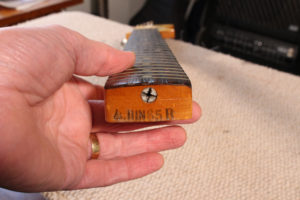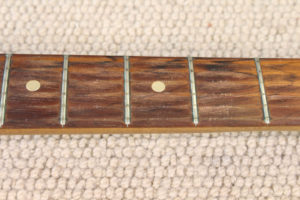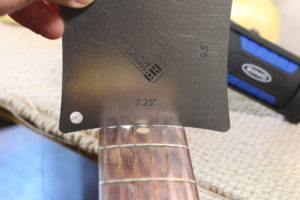Refret a 1965 Fender Jazzmaster
1965 Fender Jazzmaster: Refret or leave it as it is?
I was asked by a customer to refret a 1965 Fender Jazzmaster. Now, every week I see guitars that have worn and indented frets. And so I discuss with the owner whether the frets can be levelled, re-crowned and dressed, or whether it is best to install new frets. And then along comes a guitar where the frets are so low and worn that the only real option is to replace the frets. And this 1965 Fender Jazzmaster certainly fell into that second category. (if you would like to watch the video I made about this refret rather than read the rest of this post click HERE)


This Jazzmaster was originally fitted with frets that were 2mm wide and 1mm tall. After 55 years of playing the frets were down to about 0.5mm in height and almost down to the fretboard in those area where the strings run over the frets. Once frets get to this level of wear string bending becomes difficult, intonation is less accurate and it is harder to sound a true chord. To my ear this guitar also sounded lifeless. This is because the frets were inhibiting sustain. So to the question; refret a 1965 Fender Jazzmaster or leave it as it is with the original frets? Well I believe that it was time to refret this guitar and breath new life back into it. I was also confident that it would sound so much better once the refret was done.
Heavy fretboard wear
It is quite common to see guitars made in the 50’s and 60’s that have a lot of fretboard wear, particularly those with rosewood fingerboards. But I don’t think I a have seen a guitar where the wear is this pronounced.

Removing frets from Fender guitars made in the 1960’s
I say a lot more about this issue in the video. But in short, when this guitar was made Fender used a unique method to install their frets. Rather than installing the frets from the top of the fretboard by tapping or pressing them into the slots, the frets were pulled in from one side of the fretwork. So the preferable way to remove the frets is to drive them out the way they were pulled in.
However, the frets on this guitar were so low that, using my normal technique, I was unable to drive the frets out sideways. So I had to remove the frets by pulling them out in the conventional way. The danger with this technique is that, with regards to 60’s Fender guitars, there is greater likelihood of pieces of wood chipping out along the fretwire slot as the frets are removed. So I had to take great care when removing the frets. Fortunately there was no chipping at all.
Job complete
It is not every day I get to refret a 1965 Fender Jazzmaster. But it is always a joy to work on such a guitar.

So how did the guitar play and sound once all the work was done and the guitar set up properly. Well, I think it best to leave this to the owner of the guitar who posted this comment on my YouTube channel.
I’m the proud owner of this ’65 Jazzmaster and it’s fascinating to see the work that went into the refret. I was quite nervous about getting the guitar refretted as I’ve had the guitar for almost exactly 30 years and it played beautifully until the last couple of those. It was the first great guitar I ever owned, bought with my first job’s Christmas bonus, and is still my favourite. Thankfully David did a magnificent job on the refret. We discussed what repairs we could carry out on the fretboard and I’m so pleased that we kept all the original character and history. I always loved the feel of the neck and fingerboard and all that has been retained whilst giving the guitar the chance to sing again. Playing the guitar again, after the refret, was like welcoming back an old friend but with a clean bill of health. It sounds and plays better than I ever remembered and, if anything, makes me play better as a result. My only regret is waiting so long. Finally, an unexpected bonus of leaving my Jazzmaster in David’s hands is that he is the first person to properly balance the floating/locking tremolo. Breaking a string is no longer the out-of-tune disaster it once was!
If you would like to know more about fret levelling, fret dressing or refrets at Flame Guitars please visit my fretwork and refrets page.
And feel free to CONTACT me should you want to discuss fretwork on your guitar.
